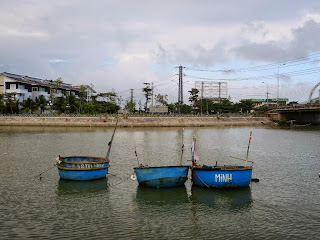In Nha Trang we started our explorations with a short cab ride to the Champa temples of Ponagar. Although there used to be many temples here, only 4 remain. They are still used by local worshippers, but the site has largely turned into a tourist attraction with dance performances and souvenir vendors. Nevertheless, they are worth the trip. The grounds are very well maintained and the temples have been restored and are decorated inside.
After the temples we decided to walk back into town, about a 45 minute walk over 2 bridges and through Xom Bong island. The road through the island is completely developed and looks like the rest of the city. I think I was expecting something different and a bit more scenic, since it's such a small island on the river with only one road (pictures 14 & 15).
Back in town, we passed the Victory Monument depicting a soldier holding doves surrounded by children.





















































